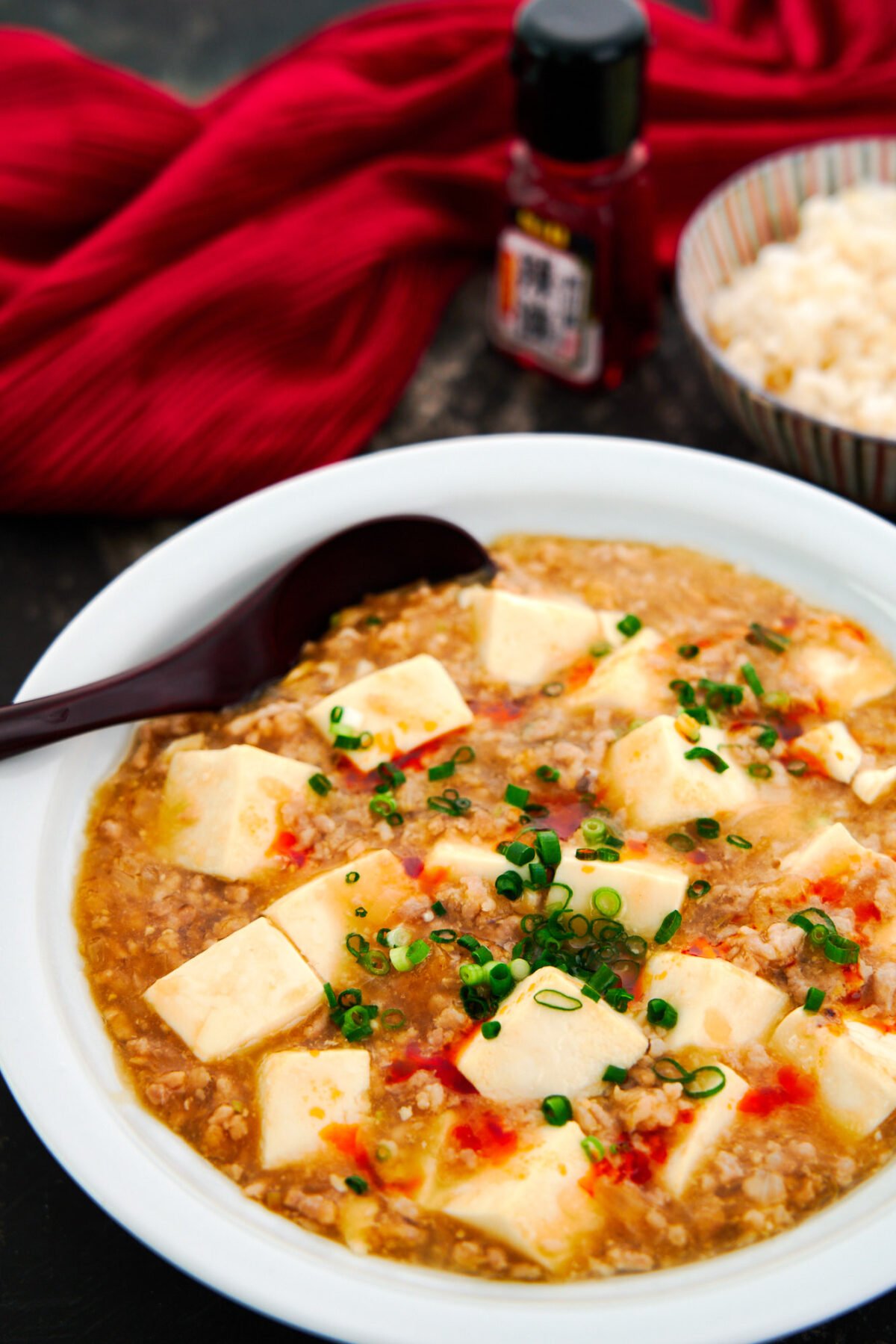
Japanese Mapo Tofu (マーボー豆腐 - Mabo Dofu)
Mabo Dofu is a Japanese adaptation of Sichuan Mapo Tofu. In the same way that American Chinese food has been adapted to use locally available ingredients to appeal to American tastes, there is a whole genre of Japanese-style Chinese cuisine called wafu-chuka (和風中華 - literally Japanese-style Chinese).
Jump to:
Compared to the Sichuan original, Japanese Mapo Tofu has a milder flavor, sweeter taste, and is much less spicy. I prefer the fiery original version of the dish these days, but there's something very comforting about the Japanese adaptation that I crave from time to time. It's also an excellent alternative for families with kids or for people who don't have a high tolerance for heat.
Why This Recipe Works
- The use of ingredients such as miso and mirin gives the Japanese version of this dish a milder flavor, while adding the rayu (chili oil) allows you to adjust the level of heat at the table.
- Browning the aromatics with miso creates a very flavorful base for the dish.
- Mixing all of the sauce ingredients with the starch cuts out a few steps, making this dish's preparation even easier.

Ingredients for Japanese Mapo Tofu
- Aromatics - The aromatics that form the basis for the Japanese version of Mapo Tofu are garlic, ginger, and some kind of onion. I've used ordinary yellow onions because they are easier to find outside of Japan than the Tokyo Negi (thick stemmed scallion) traditionally used in this dish. Mincing the onions and grating the ginger and garlic get them to brown faster and distribute their flavors more evenly.
- Ground Meat - Ground pork is the traditional meat to use for Mapo Tofu in Japan, but you can use ground chicken or beef if you like. Also, if you plan on making this plant-based go check out my Vegan Mapo Tofu for a blend of mushrooms that will work as a substitute.
- Stock - I used chicken stock, but any flavorful stock, including pork, vegetable, or mushroom stock, will work here.
- Mirin - A key characteristic of Japanese cuisine is to use sweetness to balance the salt in a dish, and Mabo Dofu is no different. Instead of using sugar, I like to use mirin for this, which not only adds sweetness, it also adds umami. Just make sure you are using real mirin. It should only include rice, water, koji, and alcohol in the ingredients and will NOT contain any corn syrup, sugar, MSG, or salt. If you can't find real mirin, you can substitute 1 tablespoon of sake plus 2 teaspoons of sugar.
- Oyster Sauce - Oyster sauce not only seasons the dish but also adds a ton of umami. If you need to substitute, you can use 2 teaspoons of soy sauce and 1 teaspoon of sugar instead.
- Toasted Sesame Oil - Toasted sesame oil has a nutty flavor and is frequently used as a seasoning in Japanese-style Chinese dishes.
- Potato Starch - The starch thickens the sauce. Traditionally a slurry of water and starch are added at the end to thicken the sauce, but the tofu doesn't take long to warm up, so I find it's easier to mix the starch with the sauce ingredients before adding them to the pan. You can substitute other types of starch, but I generally prefer potato starch because it thickens without getting gluey, and the viscosity of the sauce doesn't change much even after it has cooled (cornstarch will get hard).
- Tofu - I like using silken tofu for this dish. It's produced using a different process from regular tofu, giving it a smooth custardy texture that jiggles like Jello. It's also sometimes labeled "soft" tofu, but the problem is that I've seen brands selling softer regular tofu as "soft tofu," which is more like the medium-firm tofu sold by other brands. If you want to make sure you get the right one, look for the green package by House Foods.
- Garnishes - I like to garnish my Mabo Dofu with a sprinkle of chopped scallions and a splash of rayu (chili oil), but these are both optional, and you can adjust the amount to taste.
How to Make Japanese Mapo Tofu
To avoid a mad rush to get everything into the pan at the end, I usually like to mix all of the sauce ingredients for Mabo Dofu before I start cooking. To do this, just whisk the chicken stock, mirin, oyster sauce, toasted sesame oil, and potato starch together and set them aside.
Then you want to create a base of flavor by preheating a frying pan and browning the onions, garlic, ginger, and miso together in vegetable oil. The Maillard reaction occurs as the ingredients brown, creating a ton of new flavor compounds which give the sauce depth.
Next, you want to add the ground meat and break it up into small pieces using a spatula. This helps disperse the meat into the sauce so that it coats each block of tofu more evenly.
When the pork is cooked through, you'll want to give the sauce another stir to recombine any settled starch and then add it to the pan, along with the tofu.
To finish off the Japanese Mapo Tofu, heat the tofu through. When the tofu is hot and the sauce is nice and thick, it's ready to serve.
Garnish with scallions and chili oil to taste.

Other Japanese Chinese Recipes
FAQ
Mabo Dofu (マーボー豆腐) is the Japanese pronunciation of Mapo Tofu. It is much less spicy than the Chinese original and has a sweeter and more mellow flavor due to the use of Japanese ingredients like miso and mirin.
Like many dishes of Sichuan origin, Mapo Tofu was first popularized in Japan by Chen Kenmin. Born in Sichuan, China, chef Chen emigrated to Japan in the early 1950's where he started Shisen Hanten(四川飯店). Realizing quickly that Japanese diners were not used to the potent spiciness of the dishes from his homeland, he adapted the recipes using local ingredients. Mabo Dofu and Ebi Chiri are two of the most popular Chinese dishes in Japan, and chef Chen is credited with creating both of them. To this day, Shisen Hanten is one of the best-known chains of Chinese restaurants in Japan, and his son Chen Kenichi was the Chinese chef on the original Iron Chef for its entire 6-year run.
These days, Mabo Dofu has become a staple of home cooking in Japan, with most home-cooks opting to use "instant" packets of sauce that are heated together with tofu to make a quick meal. There are also variations on this dish such as Mapo Nasu, which is made with eggplant instead of tofu.
Mabo Dofu consists of two two-syllable words pronounced as follows:
ma like mall
bo like boat
do like don't
fu like fool
No, neither the original version of this dish or the Japanese version is plant-based. It is fairly easy to make this plant-based, though, by making a few substitutions. You can use ground mushrooms for the meat, vegetable or mushroom stock in place of the chicken stock and soy sauce with a bit of sugar in place of the oyster sauce. I have a recipe for Vegan Mapo Tofu you can check out for details on what mushrooms to use.
📖 Recipe

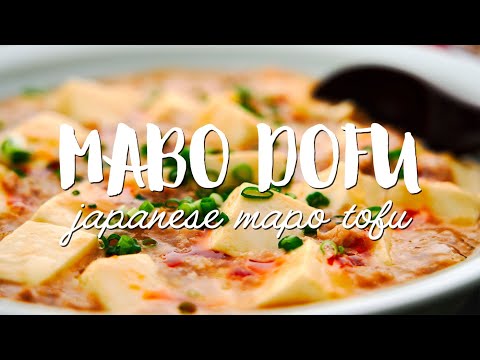
Units
Ingredients
Mabo Dofu Sauce
- ⅔ cup low sodium chicken stock
- 1 tablespoon mirin
- 1 tablespoon oyster sauce
- 2 teaspoons toasted sesame oil
- 1 tablespoon potato starch
For Stir-Fry
- 1 tablespoon vegetable oil
- 60 grams onion (½ small onion, finely minced)
- 9 grams grated garlic (1 very large clove, grated)
- 9 grams grated ginger (equal amount to garlic, grated)
- 1 tablespoon miso
- 150 grams ground pork
- 396 grams silken tofu (1 block cut into ½-inch cubes)
To Serve
- Chili oil (to taste)
- Scallions (chopped for garnish)
Instructions
- To make the sauce for the Mabo Dofu, add the chicken stock, mirin, oyster sauce, toasted sesame oil, and potato starch to a bowl and whisk to combine.

- Preheat a large frying pan over medium-high heat until hot. Add the vegetable oil, onions, garlic, ginger, and miso, and stir-fry the mixture until the onions are tender and the miso starts to brown.

- Add the ground pork to the pan and use a spatula to break it up into small crumbs.

- When the pork is cooked through, give the sauce ingredients another stir to reincorporate the settled starch and then pour it into the pan. Add the tofu and gently spread it around so that it's submerged in the sauce.

- Cook the tofu in the sauce, stirring gently or tossing, until the tofu is heated through and the sauce has thickened.

- Serve your Japanese Mapo Tofu garnished with scallions and chili oil to taste.



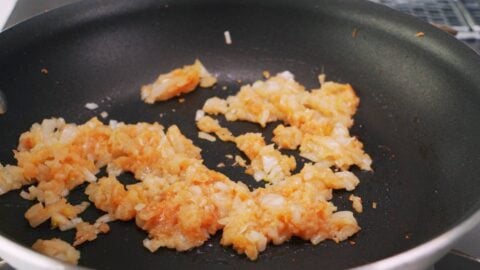

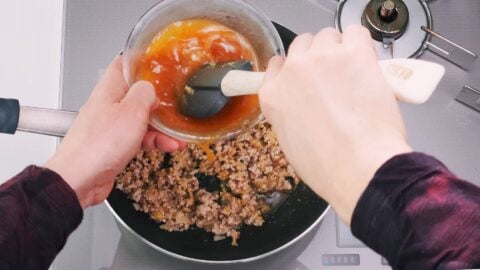
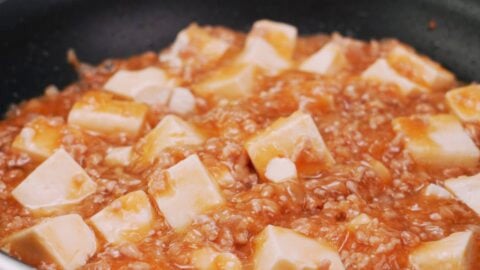
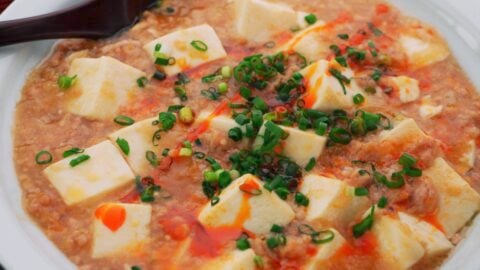
DJ says
So I started grating the onion for fun and it makes a really interesting sauce--a bit thicker than minced. I also don't get kids "searching for onion" anymore! Ground pork really works so much better than beef (doesn't overwhelm the other flavors). Thanks again!
Marc Matsumoto says
Hi DJ, that's a cool trick! Not sure if you saw it over on the other site, but I think it would work well in Taco Tofu too: https://marcsrecipes.com/taco-tofu/
DJ says
Superb version of this classic dish. The freshly ground ginger and garlic really make it pop (don't skimp with anything from a jar). Mild enough taste for very small kids, even though I add about 1 tsp of doubanjiang--and then let the grown-ups drizzle some ra-yu. What happened to your "everything's better with an egg on top" mantra? =) I just love an egg yolk in the middle of this dish, even if not too traditional at all. Perfect proportions (especially beef:tofu) as usual with all your recipes. By far the best mabo dofu I've ever made (even on the first attempt). Much obliged, Marc!
Marc Matsumoto says
Thanks DJ! Good call reducing the doubanjiang and adjusting with rayu, that's what we do too. This was a my favorite tofu dish (actually the ONLY tofu dish I liked) growing up. It's one of my favorite all time foods to this day. Also love the idea of adding an egg on top. I might have to try it with onsen tamago on top next time! Happy New Year!
Quyen Ngo says
My son is a fan of Mapo Tofu. I always have box of instant Mapo tofu sauce box in the pantry but we ran out today so I decided to use your recipe to make it. Never go back to instant sauce again! My son said the Mapo Tofu is much better this time. Thank you for your wonderful recipes!
Marc Matsumoto says
Yay! I'm happy to hear your son enjoyed it so much! Thanks for taking the time to let me know😀
kim says
Thank you Marc for the delicious recipe!
The seasonings formula is perfect to taste I didn't have to do any adjustment!
I followed the recipe exactly with the only exception of replacing meat with chopped mushroom and it turned out wonderful!
Marc says
Hi Kim, I'm so happy to hear you enjoyed this! Thanks for taking the time to report back on how it went!
Judy says
Thank you for this recipe! I have tried multiple mapo tofu recipes but never truly liked it until I tried yours!
I used my milk frother to mix the sauce together and substitute the meat with Impossible plant based patty from Costco and it turned out lovely!
I can't wait to make it for my family!
Marc Matsumoto says
Thanks Judy, I'm glad to hear you enjoyed it! Next time you may consider trying to add some ground mushrooms to the mix for a little more flavor https://norecipes.com/vegan-mapo-tofu/
Veronica says
This is really yummy
Marc Matsumoto says
Glad to hear it! Thank you for taking the time to let me know 😄
Kayla Roberts says
Our first time having this soup and it’s so comforting. Thank you for the recipe!
Marc Matsumoto says
Happy to hear you enjoyed it Kayla! Thanks for reporting back😀
Uhura says
I used your recipe as a guideline since I had a lot of ground beef to use (carnivores in the family) and it turned out wonderfully! I sautéed some toubanjang along with the aromatics + miso. Topped with green onions as well. The spoonful I just had to check my seasonings was yummy. Can’t wait to dig in for real!
Marc Matsumoto says
Hi Uhura, I'm glad to hear you enjoyed this! Thank you taking the time to let me know how it went. Have a great weekend!
Ginger Delin says
Very sad. The sauce never came together. Salt lacking and even when adding heat, still had no flavor.
Marc Matsumoto says
Hi Ginger, I'm sorry to hear it didn't work out. Assuming you measured everything accurately and didn't make any substitutions, here's what I think may have gone wrong. 1) Regarding the lack of salt, did you use use a low sodium chicken stock? If so, this may have been the problem. My recipes will specify if you need to use low-sodium stock, but in this case you'll want to use stock that has enough salt in it to drink as soup. As for your statement that "the sauce never came together" do you mean the sauce broke (i.e. got lumpy) or that it never thickened? If it was the former it's most likely caused by the starch not being stirred again as specified in step 4. Starch tends to settle quickly and if you don't stir it before adding it you're going to have lumps of starch that solidify and liquid that doesn't have enough starch left in it to thicken. If the sauce failed to thicken, the possibilities are 1) that you didn't stir the sauce enough before pouring the ingredients into the pan and some of the starch got left behind in the bowl 2) You didn't have the heat high enough. The liquid needs to come to a full boil for it to thicken. I hope that helps.
Chi Kei Priscilla Lau says
Hi Marc, I’ve been following your website for years and your recipe for non-spicy Mapo Tofu is one of our family favs! I noticed the ingredients have changed though, it used to include sake, oyster sauce but now has been replaced with chicken stock. I’ve tried googling it but I can’t seem to find the same recipe. Did you update the recipe ingredients? Would it be possible to get a copy of the old recipe? I don’t mean to bother you but my husband (and kids) love it and it’s a weekly dish for us. Thanks!
Marc Matsumoto says
Hi Priscilla, I've sent over an email with the original recipe. The newer version has a bit more sauce, which makes it better for having with rice, but I totally understand how it is with a family. Hope you have a chance to try this one out as well someday!
Aboud says
Hi Marc - can I get the recipe as well? I will try this version as well but I had been following the prior one for a few years too. Had been going off memory since it got updated.
Marc Matsumoto says
Hi Aboud, I've sent you an email with the recipe. Also here's a link to it for anyone else who may be looking for it: https://norecipes.com/wp-content/uploads/2021/07/mabo-dofu-old.jpg
the Book of Food says
Wonderful !